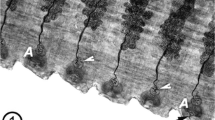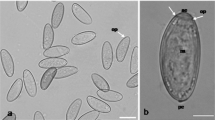Summary
The female nematode Sphaerularia bombi, wich lives in the body cavity of different species of bumble-bee queens, evaginates its whole tubular reproductive tract through the vulva. The external tube (“Sphaerularia-Schlauch”) is composed of an outer layer of former vagina cells, an internal reproductive system (uterus and ovary), and the fat body which was formerly a part of the intestine of the female worm. The ultrastructure of the cells of the tube wall and of the fat body were examined with the electron microscope. Nutrients are probably absorbed through the entire surface of the Sphaerularia-tube. The cells forming the tube wall are covered with a mucopolysaccharid layer. The apical cell membrane is characterized by short and irregular, sack-like invaginations. These contain electron-dense material. The cytoplasm of the tube cells shows a concentric, three-layer pattern: The outer layer is rich in mitochondria, Golgi bodies, lysosomes, various types of vacuoles, and endoplasmic reticulum (ER). This cytoplasmic region is very thin at the cell base. The second layer contains fewer of these organelles; however, the ER is more developed. The third or inner layer of cytoplasm is without organelles; the large nucleus is situated here. The basal cell membrane is extensively infolded. In the interior of the Sphaerularia-tube lies the fat body, which is composed of a double layer of cells. The cell membrane of these cells is irregularly formed. The cytoplasm is restricted to the outer margin of each cell and contains a number of vacuoles, mitochondria, and a large nucleus. Lipids and glycogen are deposited in all fat body cells.
Zusammenfassung
Der in der Leibeshöhle verschiedener Hummelköniginnen-Arten parasitierende weibliche Nematode Sphaerularia bombi ist gekennzeichnet durch die totale Ausstülpung seiner Geschlechtsorgane (=Sphaerularia-Schlauch). Die ausgestülpten ehemaligen Vaginalzellen des Wurmes umhüllen dabei Ovar und Uterus sowie einen Teil des Darmes, der aus dem weiblichen Wurm in den Schlauch hineingewachsen ist und als sogenannter Fettkörper Speicherfunktionen übernommen hat. Die Schlauchwand- und Fettkörperzellen wurden licht- und elektronenoptisch untersucht. Die Nahrungsaufnahme dürfte sich über die gesamte Oberfläche der Schlauchzellen vollziehen. Diese sind mit einer sauren Mucopolysaccharidschicht bedeckt. Eine Vergrößerung der nahrungsresorbierenden Oberfläche entsteht durch zahlreiche sackartige Einfaltungen der apikalen Zellmembran. In diesen Einfaltungen liegt elektronendichtes Material. Das Cytoplasma der Schlauchzellen ist deutlich konzentrisch zoniert. Die äußere Cytoplasmaschicht enthält zahlreiche Mitochondrien, Lysosomen, Golgikörper, verschieden strukturierte Vakuolen und endoplasmatisches Retikulum. Sie ist am apikalen Zellpol als breite Schicht vorhanden, während sie am basalen Zellpol nur als schmale Zone erscheint. Die mittlere Cytoplasmazone ist weniger organellenreich, dafür ist ihr ER stärker entwickelt als in der äußeren Schicht. Die innere Zone schließlich ist vollkommen organellenfrei; in ihr liegt der große Zellkern. Die basale Zellmembran hat ein kräftiges Labyrinth entwickelt. Im Innern des Sphaerularia-Schlauches liegt der aus zwei Zellagen bestehende Fettkörper. Die der „Leibeshöhle“ zugekehrte Seite dieser Zellen zeigt unregelmäßige Vorwölbungen. Das Cytoplasma der Fettkörperzellen liegt im wesentlichen randständig. Es enthält eine Anzahl von Vakuolen, Mitochondrien und einen großen Kern. In allen Fettkörperzellen werden Glykogen und Fett gespeichert.
Similar content being viewed by others
Abbreviations
- BL:
-
Basales Labyrinth
- BM:
-
Basalmembran
- BZ:
-
Buckelzelle
- E:
-
Einfaltungen der Zellmembran mit osmiophilem Inhalt
- ER:
-
Endoplasmatisches Retikulum
- FK:
-
Fettkörper
- G:
-
Golgiapparat
- L:
-
Lipideinschlüsse
- LH:
-
Leibeshöhle
- LY:
-
Lysosom
- M:
-
Mitochondrium
- MS:
-
Mucoidschicht
- N:
-
Nukleus
- NU:
-
Nukleolus
- V:
-
Vakuole
- Z1–3:
-
Zonen des Cytoplasmas
Literatur
Adam, H., Czihak, G.: Arbeitsmethoden der makroskopischen und mikroskopischen Anatomie. Stuttgart: Gustav Fischer 1964
Björkman, N., Thorsell, W.: On the fine structure and resorptive function of the cuticle of the liver fluke, Fasciola hepatica. L. Exp. Cell. Res. 33, 319–329 (1964)
Burton, P. R.: The ultrastructure of the integument of the frog lung-fluke, Haematoloechus medioplexus (Trematoda: Plagiorchiidae). J. Morph. 115, 305–318 (1964)
Burton, P. R.: The ultrastructure of the integrument of the frog bladder fluke, Gorgoderina sp. J. Parasit. 52, 926–934 (1966)
Dogiel, V. A.: General parasitology, 3rd ed. Edinburgh and London: University Press 1964
Erasmus, D. A., Öhman, C.: Electron microscope studies of the gland cells and host-parasite interface of the adhesive organ of Cyathocotyle bushiensis (Khan, 1962). J. Parasit. 51, 761–769 (1965)
Hattingen, R.: Beiträge zur Biologie von Sphaerularia bombi (Leon Dufour, 1837). Zbl. Bakt., II. Abt. 109, 236–249 (1956a)
Hattingen, R.: Beiträge zur Entwicklungsgeschichte von Sphaerularia bombi (Dufour, 1836). Wilhelm Roux' Arch. Entwickl.-Mech. Org. 148, 494–503 (1956b)
Lehmensick, R.: Erfolgreiche Versuche zur Hummelzucht in geschlossenen Räumen. Zool. Anz. 157, 110–113 (1956)
Lehmensick, R.: Beobachtungen zur Epidemiologie von Sphaerularia bombi. Proc. First Int. Congr. Parasit. 1, 581–582 (1964)
Leuckart, R.: Neue Beiträge zur Kenntnis des Baues und der Lebensgeschichte der Nematoden. Abh. kgl. sächs. Ges. Wiss. 22, 567–704 (1887)
Madel, G.: Beiträge zur Biologie von Sphaerularia bombi (Leon Dufour, 1837). I. Aufzucht von Sphaerularia-Larven zu geschlechtsreifen Würmern und die Infektion von Hummelköniginnen mit Sphaerularia bombi. Z. Parasitenk. 28, 99–107 (1966)
Madel, G., Scholtyseck, E.: Die Ultrastruktur der Schlauchzellen von Sphaerularia bombi. Naturwissenschaften 59, 272 (1972)
Madel, G., Scholtyseck, E.: Fine structural study of Sphaerularia bombi (Tylenchida, Nematoda). Proc. III. int. Congr. Parasit. 1, 434–435 (1974)
Morseth, D. J.: Ph. D. thesis, University of Otago, Dunedin, New Zealand 1965
Morseth, D. J.: The fine structure of the tegument of adult Echinococcus granulosus, Taenia hydatigena, and Taenia pisiformis. J. Parasit. 52, 1074–1085 (1966)
Morseth, D. J.: Fine structure of the hydatid cyst and protoscolex of Echinococcus granulosus. J. Parasit. 53, 312–352 (1967)
Poinar, G. O., Hess, R.: Food uptake by the insect-parasitic nematode, Sphaerularia bombi (Tylenchida). J. Nemat. 4, 271–277 (1972)
Scholtyseck, E.: Neue Einblicke in die Parasit-Wirts-Beziehungen mit Hilfe der Elektronenmikroskopie. Z. Parasitenk. 31, 67–84 (1968)
Senft, A. W., Philpott, D. E., Pelofsky, A. H.: Electron microscope observations of the integument, flame cells and gut of Schistosoma mansoni. J. Parasit. 47, 217–229 (1961)
Spannhof, L.: Einführung in die Praxis der Histochemie, 2. Aufl. Jena: Gustav Fischer 1967
Stein, G.: Über das Verhalten von Hummelköniginnen bei experimentell verhindertem Winterschlaf. Verhandlungen der Deutschen Zoologischen Gesellschaft in Hamburg 1956, S. 106–111. Leipzig: Akadem. Verlagsges. Geest u. Portig K.G. (1956a)
Stein, G.: Beiträge zur Biologie der Hummel (B. terrestris L., B. lapidarius L. u.a.). Zool. Jb. 84, 439–462 (1956b)
Stein, G.: Weitere Beiträge zur Biologie von Sphaerularia bombi (Leon Dufour, 1837). Z. Parasitenk. 17, 383–393 (1956c)
Stein, G., Lohmar, E.: Über die Infektion verschiedener Hummelarten mit Sphaerularia bombi (Leon Dufour, 1837) im Raum Bonn, Frühjahr 1970. Decheniana 124, 135–140 (1972)
Threadgold, L. T.: The tegument and associated structures of Fasciola hepatica. Quart. J. micr. Sci. 104, 505–512 (1963)
Threadgold, L. T.: The tegument and associated structures of Haplometra cylindracea. Parasitology 58, 1–7 (1968)
Tischler, W.: Grundriß der Humanparasitologie. Jena: VEB Gustav Fischer 1969
Voge, M.: Observations on the structure of the cysticercus of Taenia hydatigena (Pallas, 1766). Proc. helminth. Soc. Wash. 29, 62–66 (1972)
Voge, M.: Observations on the structure of cysticerci of Taenia solium and Taenia saginata (Cestoda: Taeniidae). J. Parasit. 49, 85–90 (1963)
Waitz, J. A.: Studies of the ultrastructure of larval Hydatigera taeniaeformis. J. Parasit. 47 (Suppl), 27 (1961)
Author information
Authors and Affiliations
Additional information
Herrn Professor Dr. Dr. L. Lehmensick zur Vollendung seines 76. Lebensjahres gewidmet. Mit Unterstützung der Deutschen Forschungsgemeinschaft.
Rights and permissions
About this article
Cite this article
Madel, G., Scholtyseck, E. Licht- und elektronenoptische Untersuchungen an den Schlauchzellen des Hummelparasiten Sphaerularia bombi (Tylenchida, Nematoda). Z. F. Parasitenkunde 49, 81–92 (1976). https://doi.org/10.1007/BF00445020
Received:
Issue Date:
DOI: https://doi.org/10.1007/BF00445020




